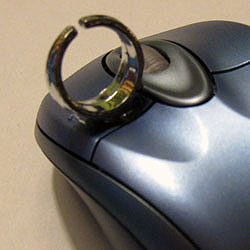REDMOND – April 30, 2009 – Mike LaManna, a designer for the Platform Components, Creation and Collaboration team within Microsoft Corp., thought he was a simple Internet search away from helping his mother.
During one of their regular Sunday morning phone calls, Janice LaManna – who works with special needs students at a school in upstate New York – asked if her son knew of any mice that would make computing easier for children with special needs. The children at her school often had trouble using computers, LaManna’s mother said, because dexterity issues caused their hands and fingers to slip off the mouse or mouse buttons. This led to unintentional clicks, and frustrated students and teachers.
“I really thought it was going to be a quick Internet search and that was it. I would find something and purchase it for her,” says LaManna. Instead, he found mice for children were mostly simply adult-sized mice repainted to look like bees or ladybugs. There were a few designed for people with disabilities, but there was no mouse or add-on device built specifically for small hands.

April 29, 2009
“It’s a little more arts and craft than it is high-tech design,” said Mike LaManna of the most effective of his mice designs, which help special needs children use computers.
So LaManna got creative. He took a box of old mice home from his lab and, over several weekends, experimented with a variety of designs and ideas. He searched for supplies at hardware, craft, and party stores. He disassembled and reassembled mouse after mouse, and even used clay to make prototypes. Once he had a few working models, LaManna sent them to his mother’s school in New York so the teachers and students could try them out.
At about this time, some of LaManna’s coworkers got wind of what he was working on and decided to help. Annuska Perkins, a senior accessibility strategist in Microsoft’s Trustworthy Computing unit – a Microsoft initiative aimed at creating secure, private, and reliable computing – also took on this project. For her, it was an opportunity to directly solve a computer-access issue for special-needs children. She often hears from special education experts who tell her that each child typically needs individually-specialized assistive technology, something for which it is difficult to find money.
Also joining the effort was former Microsoft employee Hugh McLoone, a user experience expert who also has a special needs child. That provided LaManna not only with McLoone’s skills, but also with contacts in the Bellevue, Wash., school district. Many others in the Microsoft community also contributed ideas, feedback, and materials.
McLoone, Perkins, and LaManna worked with 10 special needs children from schools in Bellevue to test the mice. Each child spent about 30 minutes working with the prototypes. The Microsoft employees used a mouse-tracking software tool to test how the prototypes worked for the children. They tried a variety of methods to gauge the reaction of the children, many of whom were nonverbal, and had to watch closely to see whether there were negative responses. LaManna and his colleagues also found that the designs they thought would be best for the children weren’t as intuitive for them to use and didn’t keep their index fingers in place.

April 29, 2009
After prototype testing, LaManna and his colleagues found that the most effective adaptation for the children involved a plastic toy ring fastened on a laptop-sized mouse.
After the prototype testing, and after receiving feedback from teachers in Bellevue and North Tonawanda, N.Y., LaManna and his colleagues found that the most effective design involved a plastic ring fastened near the back of the button on a small, laptop-sized mouse. Though the children needed some initial guidance from a teacher, and an adjustment period, the design worked to both keep their fingers on the mouse button and to more easily fit a child-sized hand. “It’s a little more arts and craft than it is high-tech design,” LaManna says. “Sometimes I get a little red in the face, working somewhere where designs go out buttoned up and pixel perfect, and I am walking around with a glue gun and a bag of party rings.”
Perkins added that the “straight-forward solution shows promise in solving the specific issue we targeted. It was exciting to see kids in the study using a computer for the first time and the mouse attachment working. This step could lead to other brainstorms.”
Ideally, LaManna says, educational or community groups hear about the idea and build on the theme of using a “found object” to do quick modifications. For now, he and his colleagues are working to spread the word about the prototype, and instructions for how parents and teachers of children with special needs can quickly and affordably create such a mouse themselves. “Somehow, if more people could know about this, people could use and build on the idea,” he says.
And that could help a lot of special needs children get a better grip on a mouse – and their future.




